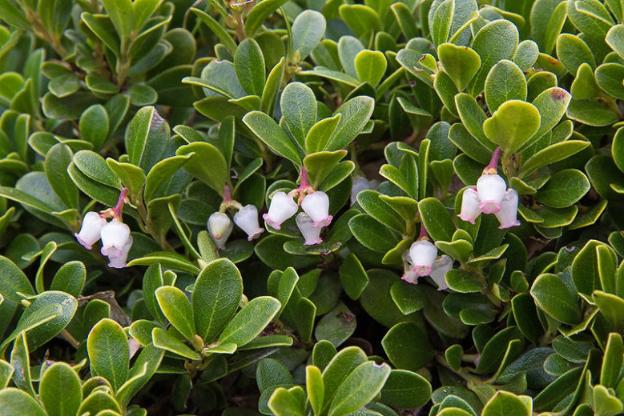

Bearberry, Common Bearberry, Kinninnick, Kinnikinnick, Pinemat Manzanita, Creeping Manzanita
Extremely winter hardy, Arctostaphylos uva-ursi (Bearberry) is a slow-growing, creeping, evergreen shrub with trailing red stems studded with small, leathery, glossy, obovate, dark green leaves, up to 1 in. long (2.5 cm). The foliage turns red or purplish in winter before becoming green again in spring. Pretty clusters of lantern-shaped, white-to-pink flowers hang gracefully from the short red stems in mid to late spring. They last several weeks and are followed by edible, smooth and glossy berries which ripen to bright red in the fall. Slow to rot, the glistening fruits provide excellent emergency food for birds and mammals throughout winter.
Bearberry makes a very attractive ground cover where few other plants would be happy. Equally lovely when draped over the edge of walls or large rocks.
| Requirement | |
|---|---|
| Hardiness | 2,3,4,5,6 |
| Heat Zones | 1,2,3,4,5,6 |
| Climate Zones | 4, 5, 6, 7, 9, 14, 15, 16, 17, 18, 19, 20, 21, 22, 23, 24, A1, 1B, 2A, 2B, 3A, A2, A3, 1A, 3B |
| Plant Type | Shrubs |
| Plant Family | Ericaceae |
| Exposure | Full Sun, Partial Sun |
| Season of Interest | Spring, Fall, Winter, Early Spring, Mid Spring, Late Spring |
| Height | 1' - 2' |
| Spread | 1' - 2', 2' - 3' |
| Water Needs | Low |
| Maintenance | Low |
| Soil Type | Moist but Well-Drained, Loam, Acid |
| Characteristics | Attracts Butterflies, Deer Tolerant, Drought Tolerant |
| Garden Styles | City and Courtyard, Coastal Garden, Gravel and Rock Garden, Informal and Cottage, Traditional Garden |
| Planting Place | Banks and Slopes, Beds and Borders, Edging, Ground Covers, Underplanting Roses and Shrubs |